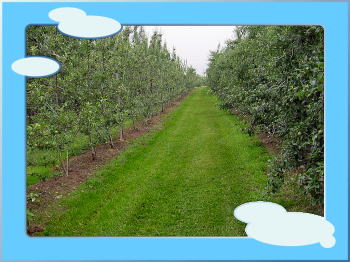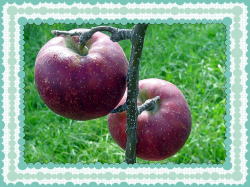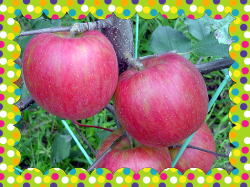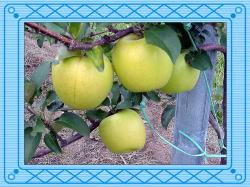●IDFTA Presentation South Tyrol Italy, 2004
Grower: Takanobu Nakamura
Nagano JAPAN

Japan has been producing apples for more than 130 years beginning in 1871. Production is between 800,000-1,000,000 metric tons of per year. The main apple growing areas are located between latitude 36° and 44°north. The two main apple-producing prefectures are Aomori (50%) and Nagano (25%) with Fuji still main variety with about 50% of production in Japan. Fuji was bred in Japan and released in 1962.
The Japanese fruit industry is clearly focused on consumers with all orchard practices aimed at giving consumers a good and predictable experience. Attention to detail in the orchards is the starting point with very intensive hand thinning to ensure large fruit are produced. Leaf removal near the fruit is one of the most important practices, which is performed 4 weeks prior to harvest. 1 ?2 weeks after leaf removal the apples are turned 180°to improve fruit color.
Seasonality is still a very important marketing tool in Japan with most areas apart from Aomori selling their fruit in 4 to 5 months. There is a considerable amount of CA storage in Aomori. Apples are harvested at optimum maturity and they seldom roll or bump into one another on the way to the consumer. They are picked into baskets and then field sorted by hand into 18kg plastic crates. At the packinghouse the apples are placed on the grader by hand, optically sized and colour sorted they then pass through a Near Infrared Spectroscopy (NIRS) machine to determine the internal qualities. NIRS is used widely in Japan and can measure sugar levels, fruit pressure, acidity, the level of watercore and internal breakdown (mouldy core etc.) and give each piece of fruit an overall maturity rating. NIRS is used to give the consumer a very predictable outcome particularly where watercore is a very important requirement for Fuji apples to have.
In Japan there are a number of very large cities Tokyo for example has 28million people so there are many that have absolutely no association with farming or a rural life style. My company Azumino Family Agr-Products Ltd (FAP) has developed a system where people from the city come to my farm and purchase the crop from 1 tree in the orchard. They generally visit in the spring and select a tree; we guarantee that there is a minimum of 150 fruits on each tree. The name of the buyer is put on a sign on the tree and they can take their photo with it. At harvest time most return to pick the fruit and enjoy some time in the country. This marketing approach has recently been adopted by many of Japanese apple growers.
To increase consumer awareness of fruit production FAP has a system where all fruit supplied to several stores in Tokyo has a coded sticker that can be scanned by the consumer. Once scanned a range or information is displayed on the computer screen including a photo of the trees in the orchard, growing techniques and chemical applications. This is designed to give the consumer a feel for what goes into making an apple.
Traditionally the son’s of farmer’s go on to become farmer’s in Japan. In Recent years not many young people born on the farm want to carry on and become a farmer. The average of apple farmers in Japan continues to increase as is now over 60 years(?) this poses a great risk to the industry. Without people committed to growing food society in general is at risk and in today’s Japanese society being an apple farmer is not seen as the “thing to do”. There are now many young people who were born in cities who want to become farmers. These people want to work with nature in the countryside away from he city and put their dreams into agriculture. However these people have no farming skills or any experience of living away from the city. I started to think about the need for a system that accepted these people as trainees. I provide an opportunity for young people to experience 4 years on my apple farm to train as farmers. Once they complete their training I support them in becoming an independent apple farmer. To date 3 people have become independent apple farmers.
I currently have 8 trainees at various stages of their training and every year 2-3 people are moving from the city to my farm to begin training. Last year the government of Nagano prefecture also saw the need for a farm training system and they began a foster parent and child system for farming. The system that I have developed was selected and 35 young people moved to Nagano from the city to become trainees and to put their dreams into become independent farmers in their future.
Almost of all apple growers are using Marubakaido rootstocks with M9 is the inter stock. Marubakaido is very easy to propagate from cuttings. But this system results in more vigorous tree growth than a dwarfing rootstock like M9. Recently we started to use M9 and JM7 on their own roots. JM 7 is a new apple rootstock in Japan it is the result of crossing M9 x Marubakaido at the National Institute of Fruit Tree Science Apple Research Center in Morioka. There are a series of JM rootstocks with JM1 and JM7 gaining in popularity. JM7 is slightly smaller in vigour than M26 but has woolly apple aphid and phytopthora resistance. M9 rootstock is susceptible to winter injury so growers have avoided it to date and as irrigation is not widely used in Japan M9 is also prone to dry stress in the summer. Japanese growers are moving to dwarfing rootstocks in their orchards.
.
Fuji is still the main variety with more than 50 % of production second in production is Tsugaru at around 10%. One of the unique points of Japanese apple growing is in varieties with almost all varieties being developed in Japan, only Jonagold and Jonathan as introductions have gained any degree of market acceptance. There are now concerns that Fuji is production is too high and that consumers are becoming a little bored with Fuji apples. The annual consumption of apples in Japan is only 5 kg per person so we need consumers to eat more apples so we need good new varieties.
Many new varieties have been released in recent year from experiment stations and private farms and breeding programs. Akibae, Shinano Sweet and Shinano Gold are the most promising varieties for us now in Nagano. These 3 varieties are mid season varieties with good taste and they store well.

Akibae is a cross of Senshu× Tsugaru originating for a private breeder Mr. Odagiri.
Bloom is early to mid May. It needs 145-155 days after full bloom to ripen. Harvest is late September. Very good deep red colour. Good balanced taste. Fruits store very well for 3 months in cold storage. Some years it has a russet problem. Trees are moderately resistant to alternaria blotch and mildew, but susceptible to scab. Akibae has a very unique dark red colour that consumers will be able to recognize very easily and is a key part of the Akibae personality.

Shinano Sweet is a cross of Fuji×Tsugaru originating from the Nagano Fruit Tree Experiment Station at Suzaka. Bloom is early to mid May. It needs 150 ?160 days after full bloom to ripen. Harvest is in early October. Good red colour with stripe the colour improves if it is grown more than 500m above see level in Japan where colouring conditions are better. Very sweet taste brix 14-15°. Acid levels are about 0.3%. Excellent storage. Trees are moderately resistant to alternaria blotch and mildew but susceptible to scab. Shinano Sweet has excellent taste with this sweet taste being the intense personality of Shinano Sweet.

Shinano Gold is a cross of Golden Delicious×Senshu originating from Nagano Fruit Tree Experiment Station at Suzaka. Bloom is early to mid May. It needs 150-160 days after full bloom to ripen. Harvest is in the middle of October. Pale green becoming yellow similar to Golden Delicious but has excellent storage for 4 months in cold storage. Good balanced taste. Trees are moderately resistant to alternaria blotch and mildew, but susceptible to scab. Shinano Gold fits well along side red apples and Fuji makes a good match with Shinano Gold on the supermarket shelf.
Many other varieties have been introduced in recent years. Several new varieties are now in my orchards and I have limited production of each.
Shinano Red: Early variety 105 ? 115 days. Harvest in mid August just before Tsugaru but storage qualities are poor.
Shinano Dolce:Mid season variety 130-140 days. Harvest in the middle of September just after Tsugaru. Round-oblong shape with good balanced taste and smaller in size than many Japanese varieties.
Azusa Fuji: Early maturing red strain. About 30 days earlier than Fuji with a good red blush colour without water core.
Gunma Meigetu : Mid season variety 150-160 days . Harvest in the middle of October about the same time as Shinano Gold. Pale green to golden a slight red blush can occur on exposed fruit. Fruits get watercore. Good sweet apple
Aikanokaori:late variety 165-175 days. Just before Fuji with fruit having water core.
Pink LadyTM(Cripps Pink):Pink Lady Japan association. All Pink Lady producers would be members of the association with a management group either elected or nominated for Pink Lady in Japan.
With only Jonagold and Jonathan as overseas varieties that have made an impact in Japan until now there is interest from growers in new varieties from outside Japan. We will accept new varieties from overseas in future with and I believe that these new varieties will change the apple industry in Japan.